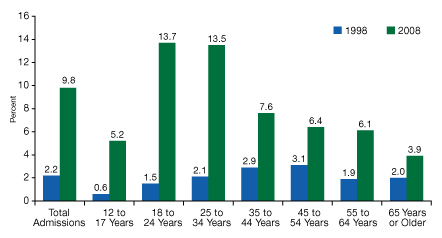Treatment Admissions: Dramatic Rise in Abuse of Pain Relievers
Increase Seen in All Ages, Ethnic Groups
By Virginia Hartman
The proportion of all substance abuse treatment admissions of those age 12 and older involving abuse of prescription pain relievers rose by over 400 percent from 2.2 percent in 1998 to 9.8 percent in 2008, according to a new study from SAMHSA.
Released at a special press conference at the National Press Club, the SAMHSA report shows that the dramatic rise in the proportion of admissions associated with the abuse of these drugs occurred among nearly all segments of the population regardless of age, gender, educational level, and employment status.
RADM Peter Delany, Director, SAMHSA Office of Applied Studies, presented the data results. To highlight the seriousness of the findings, the press conference also included R. Gil Kerlikowske, Director, White House Office of National Drug Control Policy (ONDCP); Governor Jack Markell of Delaware; Michelle M. Leonhart, Acting Administrator, Drug Enforcement Administration; and A. Thomas McLellan, Deputy Director, ONDCP.
For example, among men, the proportion of treatment admissions involving the misuse of prescription pain relievers rose from 1.8 percent in 1998 to 8.1 percent in 2008, while among women, the proportion of admissions due to misuse increased from 3.5 percent in 1998 to 13.3 percent in 2008.
The upward trend also held true among admissions for which medication-assisted opioid therapies, such as methadone or buprenorphine, were planned. Since 1998, the proportion of medication-assisted therapy admissions involving prescription pain reliever abuse tripled from 6.8 percent to 26.5 percent.
Other growing problems associated with the misuse of prescription pain relievers were recently highlighted in another SAMHSA study that found that emergency
visits to hospitals involving the nonmedical use of prescription narcotic pain relievers more than doubled between 2004 and 2008.
“The Treatment Episode Data Set report released today highlights the significant public health challenge posed by prescription drug abuse,” said RADM
Delany. “This is our country’s fastest-growing drug problem, the source of which lurks far too often in our home medicine cabinets.”
The study, Substance Abuse Treatment Admissions Involving Abuse of Pain Relievers: 1998 and 2008, was based on data from SAMHSA’s Treatment Episode Data Set (TEDS)—a reporting system involving treatment facilities from across the country. The study was developed as part of SAMHSA’s Strategic Initiative on Data, Outcomes, and Quality—an effort to inform policy makers and service providers on the nature and scope of behavioral health issues.
The full report is available on the SAMHSA Web site.
Enlarge image
 Source: SAMHSA, Office of Applied Studies (July 15, 2010). Figure 1. Percentages of Substance Abuse Treatment Admissions within Specific Age Groups that Reported Any Pain Reliever Abuse: 1998 and 2008. Substance Abuse Treatment Admissions Involving Abuse of Pain Relievers: 1998 and 2008. Rockville, MD.
Source: SAMHSA, Office of Applied Studies (July 15, 2010). Figure 1. Percentages of Substance Abuse Treatment Admissions within Specific Age Groups that Reported Any Pain Reliever Abuse: 1998 and 2008. Substance Abuse Treatment Admissions Involving Abuse of Pain Relievers: 1998 and 2008. Rockville, MD.
Text only